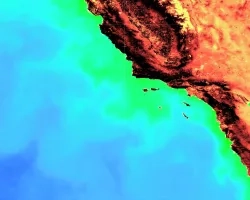Gulf of Mexico Health & Air Quality II (Fall 2022)
Team: Ben Dahan (Project Lead), Melodi Hess, Rene Castillo, Vanessa Machuca
Summary: Offshore oil and gas production in the United States is a significant source of anthropogenic greenhouse gas emissions and accounts for nearly 30% of global oil and gas production. Methane venting and flaring are primary contributors to offshore emissions, and monitoring these activities is crucial for mitigating greenhouse gas emissions. Limited ground truthing and intermittent offshore satellite revisits make monitoring venting and flaring challenging. The Bureau of Ocean Energy Management (BOEM) and the Bureau of Safety and Environmental Enforcement (BSEE) oversee offshore oil and gas activity but rely primarily on operator-reported data. The non-profit organization SkyTruth monitors natural resources like methane and identifies sources of fugitive emissions. By combining BOEM and BSEE’s operational data along with observations from Sentinel-2 Multispectral Instrument (MSI), Landsat 8 Operational Land Imager, Landsat 9 OLI-2, and PRecursore IperSpettrale della Missione Applicativa (PRISMA), the team further identified ultra-emitter point sources in the Gulf of Mexico using sunglint-configured imagery. We quantified these plume emission rates using the methodology from Varon et al. (2020). The team found 3 plumes in the Gulf of Mexico from 2020 to 2022 in Sentinel-2 MSI and Landsat 9 OLI-2 imagery in addition to the single plume identified last term and successfully quantified 3 plumes. Our statistical retrieval of 3 PRISMA images taken over areas of interest yielded no methane plumes, despite a successful test of a known plume in Assam, India. These analyses serve as a proof of concept for the utility of remote sensing for methane emission monitoring offshore, which can complement regulator emission inventories and validate self-reported operator records.



